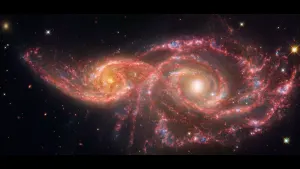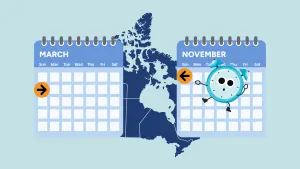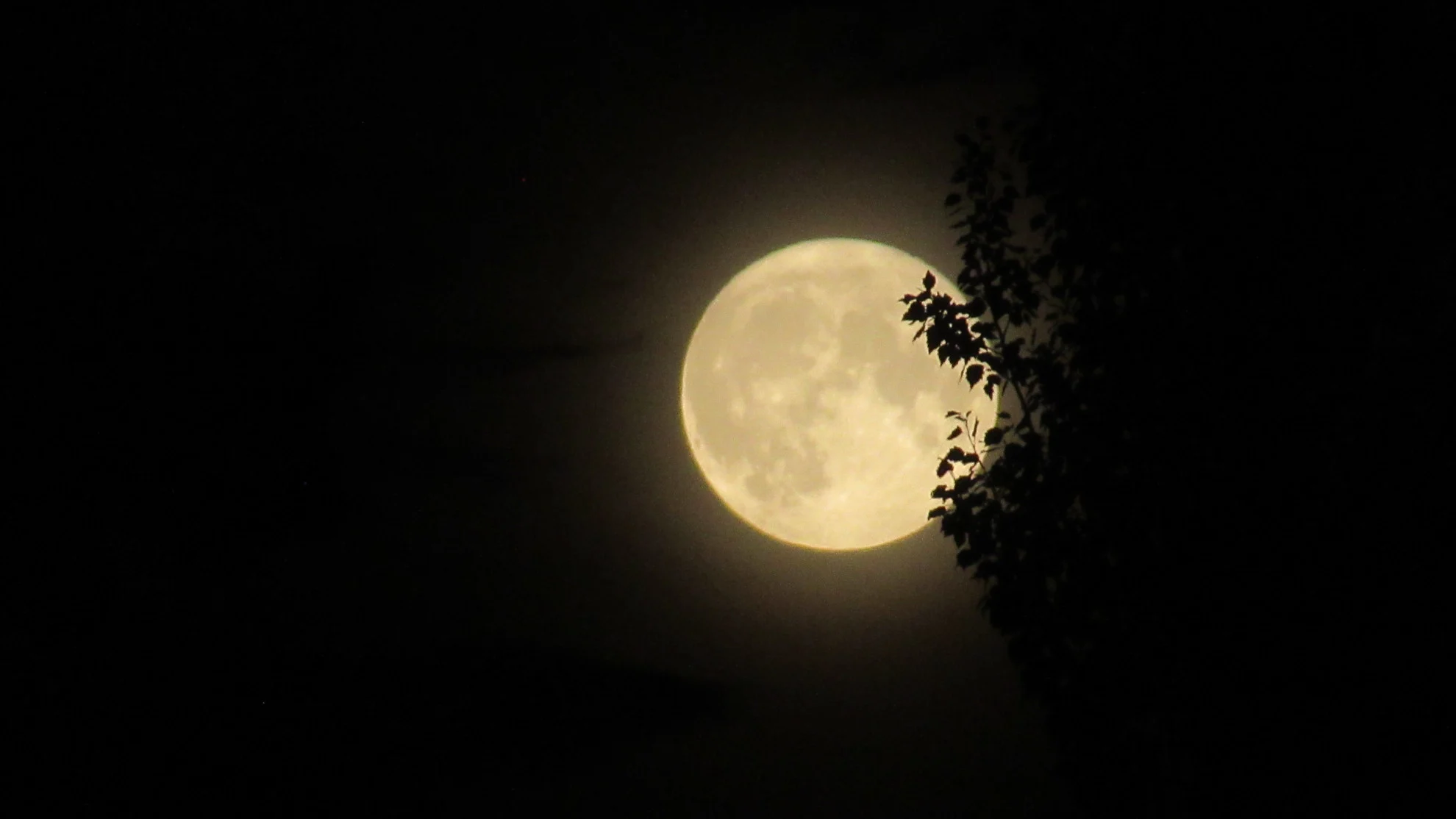
Look up! The first of two August Full Moons rises tonight!
Why have only one Full Moon in a month, when you can have two?
The Super Sturgeon Moon rises tonight, which means we'll see a super-rare Super Blue Moon at the end of August!
Turn your eyes to the eastern horizon in the early evening on Tuesday, August 1, to watch 2023's Full Sturgeon Moon rise. The Moon officially reaches its 'full' phase at exactly 18:33 UTC (2:33 p.m. EDT) on the 1st. However, at a casual glance, it will appear that we have a Full Moon from Monday night through Wednesday evening.
What is a 'super' moon?
You may notice that, throughout the year, some Full Moons seem bigger and brighter than you'd expect. Partly, this is due to a trick of the mind called the Moon Illusion (more details on that below). However, there are times when the Moon is larger and brighter in our sky due to its elliptical orbit around the Earth.

This infographic shows the thirteen Full Moons of 2023, along with their popular names and other noteworthy information, but each is also appropriately scaled to indicate its relative size compared to the others. The Full Moons of July, August, and September are 2023's supermoons. Credit: Scott Sutherland/NASA/Fred Espenak
If the Moon followed a circular path, it would always appear the same size to us, no matter what. Its elliptical orbit means that its distance changes throughout each orbit. While the average distance of the Moon is around 384,400 kilometres (1 lunar distance), it can reach as far as 406,725 km away from Earth and come as close as 356,355 km.
When the Moon is farther away from Earth, it appears smaller and dimmer; when it's closer to Earth, it appears bigger and brighter.
In 1979, astrologer Richard Nolle came up with a new term to describe those Full Moons that occur when the Moon is near its closest approach and thus are the biggest and brightest. He called them supermoons.
The difference in apparent size between a typical Full Moon and a supermoon is small enough that it's challenging to really notice it. What's much more noticeable is the increased brightness of a super Full Moon. According to Fred Espenak's Astropixels site, the August 1 Full Moon is roughly 30 per cent brighter than February's 'micromoon' (the farthest, smallest, and dimmest Full Moon of 2023) and about 15 per cent brighter than the 'average' Full Moons we saw in April and May.
In 2023, there are four supermoons on July 2-3, August 1-2, August 30-31, and September 28-29.
--
DON'T MISS: See two summer meteor showers light up the night this weekend
--
Where does the name 'Sturgeon Moon' come from?
In the 1930s, the Maine Farmer's Almanac wrote down a list of names for each Full Moon of the year. Most were taken from First Nations lunar calendars, but there were also Colonial and European folklore influences. Since then, these names have become popular and are widely used by the public and media.
According to The Old Farmer's Almanac, the August Full Moon is typically known as the Sturgeon Moon.
"The sturgeon of the Great Lakes and Lake Champlain were said to be most readily caught during this Full Moon," the Almanac says.
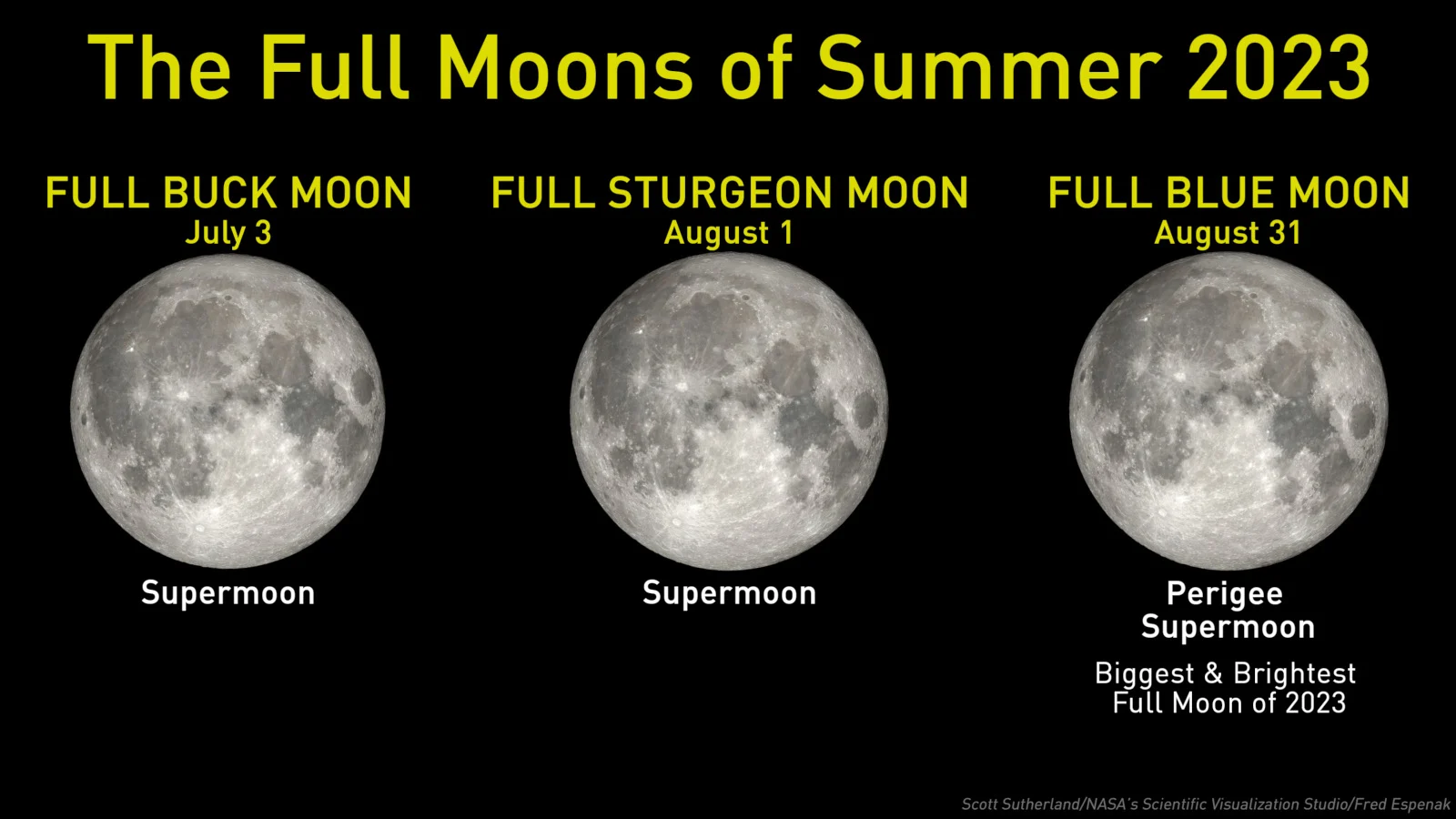
The three Full Moons of Summer 2023. Credit: Scott Sutherland/NASA/Fred Espenak
The Farmer's Almanac (yes, there's more than one) attributes Sturgeon Moon to the Algonquin peoples of the Great Lakes and what is now the U.S. Northeast. It was also known as the Corn Moon.
It's important to note that these names are not specifically for the Full Moon alone. First Nations peoples tracked the passage of each year using a lunar calendar. Each name, therefore, referred both to the Full Moon and the roughly 29-day period ('lunation') between then and the next Full Moon. The exact names that went with each lunar calendar varied depending on what language was spoken, what part of the continent the people lived in, and what their lived experiences were throughout the year.
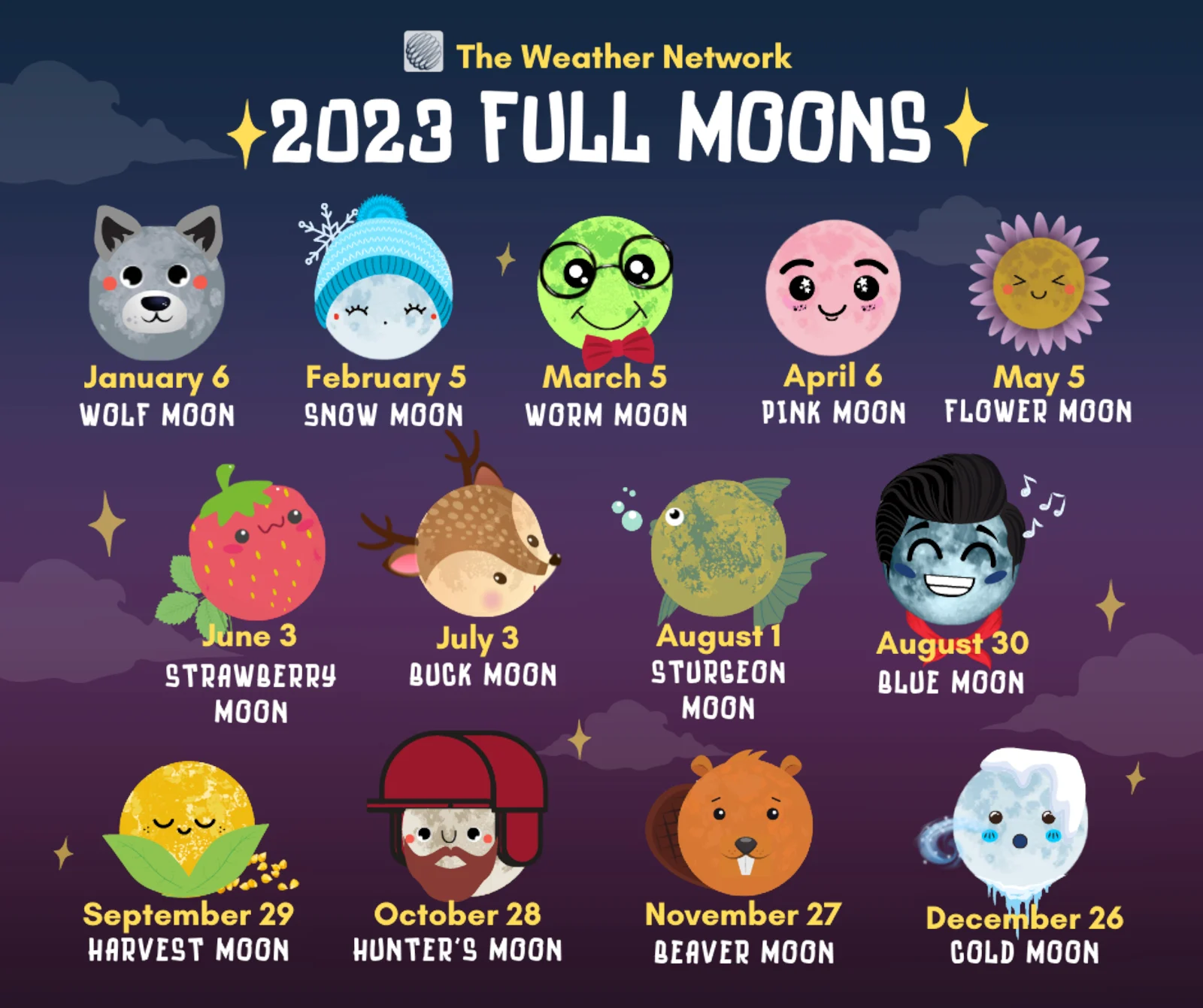
"Some names are more general, such as the 'Harvest Moon' used by the Dakota," the Farmer's Almanac said. "'Moon of the Ripening' from the Lakota tribe has a similar connotation, indicating ripening harvests. 'Green Corn Moon' or simply 'Corn Moon' is used by the Algonquin and Ojibwe tribes."
"The Sioux and Assiniboine tribes of the northern plains and into Canada call this Moon the 'Black Cherries Moon' in reference to ripening chokecherries, while the Shawnee tribe of Ohio and Pennsylvania have named this Moon the 'Plum Moon' for those delicious fruits," they wrote. "The August full Moon is called the 'Feather Shedding Moon' by the Passamaquoddy tribe of the northeast, the 'Geese Shedding Their Feathers Moon' by the Arapaho of the central plains, and the 'Moon Young Ducks Begin to Fly' by the Cree of eastern and central Canada."
"In August, temperatures rise and streams and rivers can dry up, leading to the name 'Dry Moon' by the Catawba of South Carolina, as well as the 'Drying Up Moon' by the Cherokee in the central eastern United States," they added. "Similarly, the name 'Hot Moon' from the Tunica tribe of Louisiana and the Shoshone tribe of Nevada and Wyoming references the season's high temperatures."
--
READ MORE: A super-rare Perigee Blue Moon lights up the night sky this summer
--
A rare Blue Moon
With the Sturgeon Moon occurring on the first night of August, there's just enough time left in the month that the Moon will complete a full orbit around, and we'll see a second Full Moon on the night of August 30-31.
This second Full Moon in a calendar month is a special one. Not only is it a Blue Moon, but it's also a Perigee Moon — the closest, biggest and brightest Full Moon of the entire year.

This image of the August 31 Perigee Blue Moon is a composite from the Lunar Reconnaissance Orbiter. Credit: NASA's Goddard Scientific Visualization Studio/Scott Sutherland
This combination, a Perigee Blue Moon, is a rare event. The last time we saw one was in July of 1996. The next one won't occur until December 2115 — over 92 years from now!
The Mysterious Moon Illusion
Seeing the Full Moon at any time of night is a spectacular sight. However, go out just after moonrise or before moonset to see the Moon at its biggest!
This is not something the Moon itself is doing, though. In fact, when the Moon is just above the horizon, it's actually around 6,300 kilometres farther away from you than when it is directly overhead.
Instead, the apparent size of the Moon when it is close to the horizon is due to a little trick of our mind known as The Moon Illusion.
As our eyes take in the world around us, our brain knows from experience that objects close to us tend to appear larger and in focus. In contrast, distant objects tend to be tiny and blurry. From this, it also knows that for a distant object to appear in focus, it must be enormous.
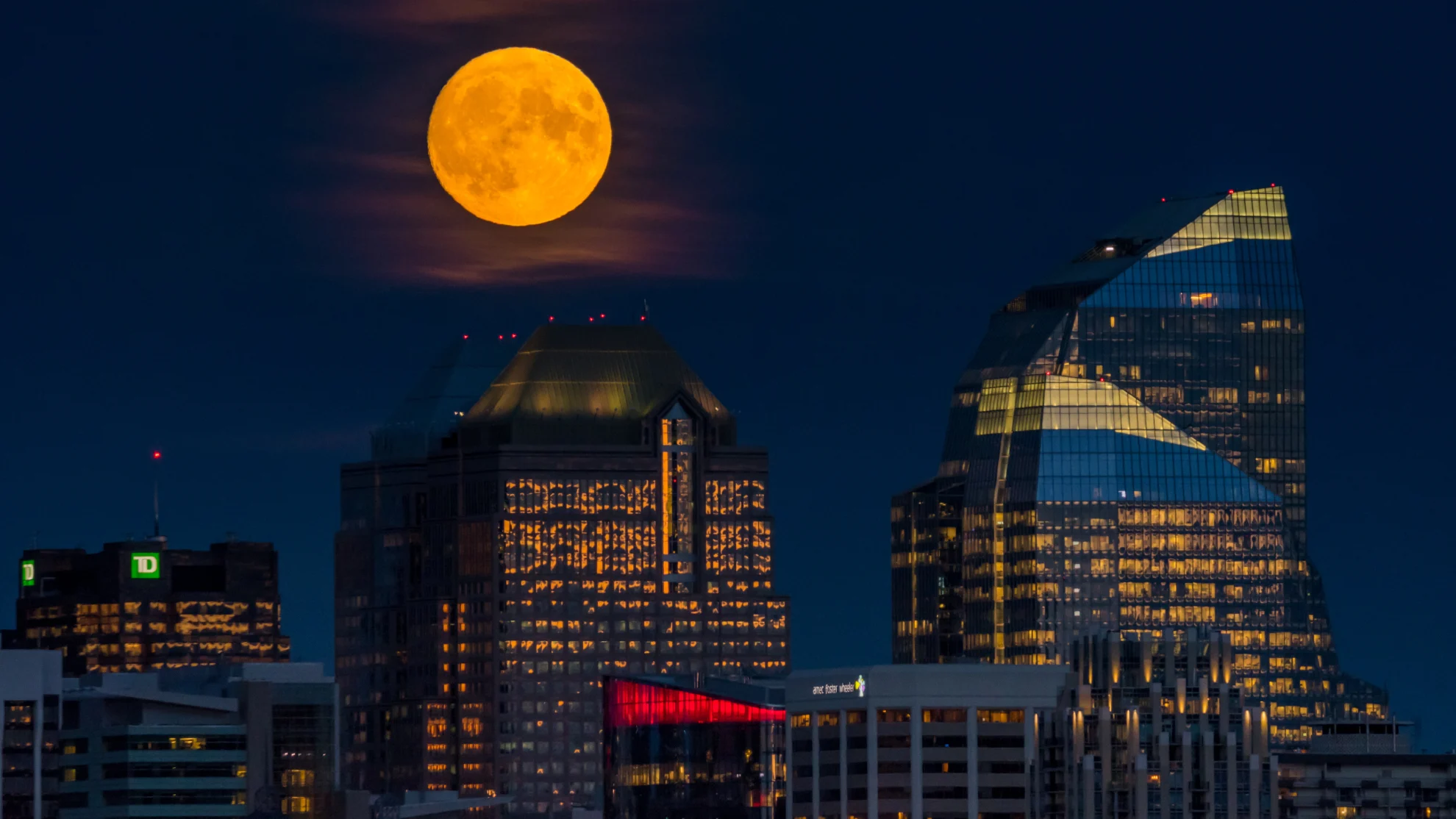
This close-up of the September 2019 Full Moon was snapped in Calgary, AB, during the Chinese Moon Festival. Although the camera zoomed in on the scene, if viewed in person, the Full Moon would still look immense next to the city's downtown skyscrapers due to the effects of the Moon illusion. Credit: Siv Heang Tav/UGC
So, when we see a bright Full Moon hanging crisp and clear in the sky above the horizon, it is contrasted by all of the objects on the ground, which appear smaller and blurrier the closer they are to the horizon. This combination confuses the brain. So, to compensate, the brain interprets the Full Moon as much bigger than it truly is. To be clear, the Moon is certainly much larger than any of the objects on the horizon (it's 3,474 km across), but this 'illusion' gives us the impression that the Moon looks enormous!
Look up into the sky closer to the middle of the night, and the Moon will be high above our heads. Usually, it will be the only thing we see, other than the stars and maybe a few planets. At that time, the brain is focused only on the Moon, and without the other objects in the field of view to complicate matters, it is free to just 'see' its actual size.
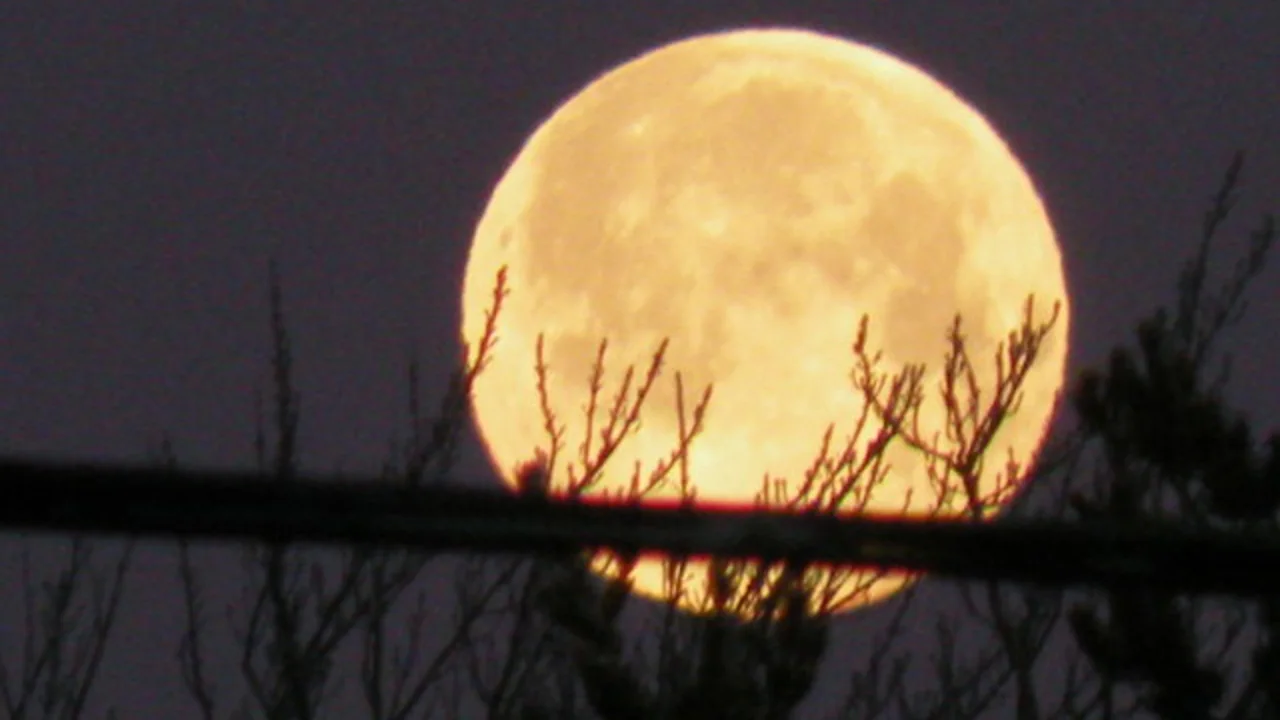
This zoomed-in image of the Full Moon was captured from Salisbury, NB, on February 9, 2020, and uploaded into the Weather Network's UGC gallery. Credit: Darlene MacLeod/Smith
We have a few tricks of our own that can cancel out the Moon illusion, though.
For the first one, we don't need technology. Just go outside after sunset and find the Moon near the horizon. Stretch your arm towards it, and cover the Moon with your thumb or even your pinky finger. Note how big the Moon looks compared to the digit in question, and keep that in mind. Maybe even take a picture of it if you want. Later in the night, check out the Moon again when it is high in the sky. It may appear smaller than when you saw it earlier, but repeat the step to cover it with your thumb or finger. Compare it with what you saw before, and you'll find that the Moon is precisely the same size at both times.
There is a way technology can help us, though. When the Moon is low on the horizon, take out your cell phone, turn your camera on, and point it at the Moon. Note: it is possible for the Moon illusion to still work on us when looking at a picture or video. This is because the brain will make the same judgments of distance, blurriness, and size as it did when looking at a 'live' scene. Still, directly comparing what we see in the sky at that time to what is shown on our small cell phone screen can help put things into better perspective. Plus, you can also take a few pictures to upload into the Weather Network UGC Gallery while you're at it!
(Thumbnail image courtesy of Melanie Chung, who uploaded her picture of the August 2022 Super Sturgeon Moon into the Weather Network UGC gallery)









